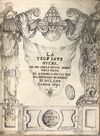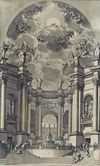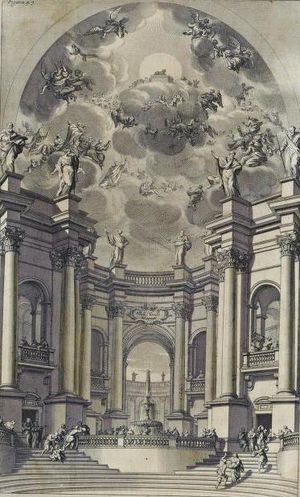Difference between revisions of "Jesuit Drama"
| (One intermediate revision by the same user not shown) | |||
| Line 61: | Line 61: | ||
|-| | |-| | ||
Italian= | Italian= | ||
| − | |||
<br> | <br> | ||
{| style="margin:auto" | {| style="margin:auto" | ||
| Line 78: | Line 77: | ||
| [[Jesuit_Drama_Works_Form|Explore]] || [[Jesuit_Drama_Digitizing_Project|Explore]] || [[Jesuit_Drama_Bibliography|Explore]] | | [[Jesuit_Drama_Works_Form|Explore]] || [[Jesuit_Drama_Digitizing_Project|Explore]] || [[Jesuit_Drama_Bibliography|Explore]] | ||
|} | |} | ||
| − | + | ||
| + | |||
L’APUG conserva nei fondi CURIA, APUG e COLLEGIO ROMANO numerosi manoscritti di opere teatrali realizzate dai professori di retorica del Collegio Romano e di altri collegi gesuiti, a partire dalla metà del ‘500.<br> | L’APUG conserva nei fondi CURIA, APUG e COLLEGIO ROMANO numerosi manoscritti di opere teatrali realizzate dai professori di retorica del Collegio Romano e di altri collegi gesuiti, a partire dalla metà del ‘500.<br> | ||
Il teatro dei Gesuiti raccolse l’eredità delle rappresentazioni sacre, ma anche del dramma classico, inserendosi nelle dinamiche del teatro barocco. I secoli del massimo splendore furono il XVI e il XVII, ma si mantenne vivo fino al XIX secolo. Il repertorio è composto prevalentemente da tragedie latine, ma non mancano opere scritte nelle diverse lingue nazionali. Autori, e curatori della messinscena, erano quasi sempre i docenti di retorica; a recitare erano gli allievi. Lo stesso testo si rappresentava in più collegi e talvolta veniva modificato per l’occasione.<br> | Il teatro dei Gesuiti raccolse l’eredità delle rappresentazioni sacre, ma anche del dramma classico, inserendosi nelle dinamiche del teatro barocco. I secoli del massimo splendore furono il XVI e il XVII, ma si mantenne vivo fino al XIX secolo. Il repertorio è composto prevalentemente da tragedie latine, ma non mancano opere scritte nelle diverse lingue nazionali. Autori, e curatori della messinscena, erano quasi sempre i docenti di retorica; a recitare erano gli allievi. Lo stesso testo si rappresentava in più collegi e talvolta veniva modificato per l’occasione.<br> | ||
Latest revision as of 12:42, 7 December 2023
| Censimento | Opere digitalizzate | Bibliography |
|---|---|---|
| Explore | Explore | Explore |
In the CURIA, APUG and COLLEGIO ROMANO fonds, the APUG conserves numerous manuscripts of plays written by rhetoric professors at the Collegio Romano and other Jesuit colleges from the mid-16th century onwards.
Jesuit theatre embraced the heritage of both sacred plays and classical drama: adapted to the dynamics of Baroque theatre (which reached its peak in the 16th and 17th centuries), it continued to thrive in later centuries. The repertoire consists mainly of Latin tragedies, but there are also works written in the various national languages. The authors and editors of the plays were almost always teachers of rhetoric; the students acted. The same text was performed in several colleges and was sometimes modified for the occasion.
An integral part of Jesuit college life (thanks mainly to the teaching programme, where the study of rhetoric played an important role), poetic and oratorical compositions paved the way for dramatic compositions and their staging. Above all, the writing of "dialogues" - orations, speeches, interludes entrusted to the masters of the Collegio Romano on the occasion of academic acts, literary tributes or greetings to illustrious guests - continued to run parallel to the production of the dramas themselves. The APUG conserves several miscellaneous specimens that attest to the existence of these particular didactic-literary works, born from the contamination of multiple genres. An example of this - one of the first - is André des Freux's dialogic poem De scientiarum honestate ac utilitate dialogus, composed in 1554 at the Collegio Romano. It was also performed outside Italy, as for instance in Coimbra, where two important Latin tragedies by Miguel Venegas: 'were staged: Saul Gelboeus (1559), and Tragoedia cui nomen inditum Achabus (1562).
The subjects of the Jesuit drama are taken from the Old Testament, martyrology and later from Greek and Roman historiography. Its ideological core, with an edifying purpose, was the clash between good and evil, both in the human soul and in the world. Of particular relevance in this regard is Stefano Tucci's trilogy devoted to the figure of Jesus, which unfolds from the nativity to Christ's triumph in the Last Judgement. In fact, by staging the death of Christ - Rex Martirum - he also paved the way for the sub-genre of the Martyr’s Tragedy. This was later reworked and perfected by Bernardino Stefonio, professor of rhetoric at the Collegio Romano and a leading exponent of what Marc Fumaroli (1932-2020) has called the “dynasty of Roman masters of oratorical art”. Based on the Senecan model, the proper Martyr's Tragedy was born with Stefonius' Crispus (1597), which was followed by his Flavia (1600). Not only compositions are preserved, but also indications on the practice and rules to be followed in the writing of the text and in the performance itself. In other words, this vast material offers an unprecedented opportunity to look not only at single cases, but also at the making and characteristics of the "poetics" of Jesuit drama.
In the PUG Historical Archive, in addition to numerous specimens of the works of Tucci and Stefonio, scrolling through the APUG index of volumes, we find the manuscripts of the rhetoricians Pedro Juan Perpinyà, Orazio Torsellini, Tarquinio Galluzzi, Francesco Benci and many others.'
Not only compositions are preserved, but also indications on the practice and rules to be kept in the drafting of the text and the actual performance.
Among the most important sources are the three unpublished volumes of the Annals of the Roman Seminary by Girolamo Nappi (1584-1648) Annals of the Roman Seminary by Girolamo Nappi in which it is possible to trace the academic life of the seminary year by year from 1563 to 1647.
State of Art
Since the international conference held in 1994 by the Centre for Medieval and Renaissance Theatre Studies (Rome-Anagni), there has been a renewed interest in various topics in the field of Jesuit theatre. In recent years, several scholars have consulted works on rhetoric in APUG with a particular interest in dramaturgical works and the way they were performed in the Colleges. The information that can be extracted from the paper files of the topographical catalogue is not only lacking but also documents a value judgement that has radically changed today. An example is the card of the miscellaneous manuscript APUG 1293 containing four operas, including the famous performance by Clement IX: La comica del Cielo ovvero la Baltasara. Of the four works present, only two were indicated, dismissing the whole as 'dramas of no value'. Referring back to a concept of value that evidently changes over time, it should be emphasised that the term valorisation, proper to economic communication, is introduced in the sphere of 'cultural goods' to indicate the desire to give a new value to a given object that had previously been de-valued. A given quality is therefore not present in the thing itself but in the observation that is made of it. It is interesting to bring out this alternation of judgement as indicative of changes or possible social developments.This shift of interest can also be seen in relation to entire collections. A famous example is the statement (21 December 1877) by the first librarian of the nascent National Library in Rome Bartolomeo Podestà concerning the discovery of the Manuscript Room at the Collegio Romano:
Although many of the objects are, as we have seen, very valuable, there are others that could not be explained why they were hidden, if not perhaps because of the haste or disturbance of mind with which the operation was conducted. By way of example, some volumes were removed from the Aldi collection, leaving in their place others of lesser importance; no thought was given to hiding volumes and pamphlets of unquestionable bibliographical value, when manuscripts and inconclusive papers were done away with.
It is precisely those inconclusive manuscripts and papers that make up about 40 per cent of the holdings preserved in the APUG today. One has to ask oneself how much scattering, discarding and neglect of documents can be attributed to such evaluations.
Lines of research
In September 2020, a CENSUS was started in the ancient fonds of the PUG's historical archives and in the Fondo Gesuitico of the Biblioteca Nazionale Centrale in Rome. This survey will be extended to the other locations that preserve theatrical documentation of Jesuit origin. Research around these issues requires a REASONED BIBLIOGRAPHY in order to detect how sources were passed on, the history of publications, the use of unpublished sources and, finally, the novelty of viewpoints in the constitution of themes and contributions.
The APUG proposes possible lines of research starting from the heritage preserved in its funds.
- Analysis of possible evolutionary traits related to the theatrical production inside and outside the Society of Jesus.
- The regulated theatre.
- The practice of Jesuit theatre between manuscript and print. Analysis of the production, circulation and reception of plays by comparing the different discursive forms produced (oration, dialogue, tragedy, etc.).
- Analysis of the possible relationship between the ars oratoria and Jesuit dramaturgical production. Analysing the possible relationship between sources of "Ignatian spirituality" and theatrical production.
If you would like to participate, individually or with your research organisation, please submit your project for evaluation by filling in the form.
Copyrights
Unless otherwise indicated, all files and contributions (transcriptions, pages, comments) uploaded and submitted to GATE by administrators and users are considered to be released under the Creative Commons Attribution-NonCommercial-NoDerivatives 4.0 International License. All the rights on the images of the manuscripts or other documentation are property of the Historical Archives of the Pontifical Gregorian University (User:ArchivesPUG). If you need high resolution images for your publications or for other usages, please contact us using this form.Your contributions to GATE must be original or, at most, copied from public domain or similar free sources. Remember to always cite your sources and, more important, do not submit copyrighted work without permission.
Report any abuses to the project administrators, using this form.
| Censimento | Opere digitalizzate | Bibliography |
|---|---|---|
| Explore | Explore | Explore |
L’APUG conserva nei fondi CURIA, APUG e COLLEGIO ROMANO numerosi manoscritti di opere teatrali realizzate dai professori di retorica del Collegio Romano e di altri collegi gesuiti, a partire dalla metà del ‘500.
Il teatro dei Gesuiti raccolse l’eredità delle rappresentazioni sacre, ma anche del dramma classico, inserendosi nelle dinamiche del teatro barocco. I secoli del massimo splendore furono il XVI e il XVII, ma si mantenne vivo fino al XIX secolo. Il repertorio è composto prevalentemente da tragedie latine, ma non mancano opere scritte nelle diverse lingue nazionali. Autori, e curatori della messinscena, erano quasi sempre i docenti di retorica; a recitare erano gli allievi. Lo stesso testo si rappresentava in più collegi e talvolta veniva modificato per l’occasione.
Il teatro gesuitico ebbe un precedente nelle composizioni poetiche e oratorie, anche studentesche, nonché nei dialoghi, richiedenti una sorta di attitudine scenica, che erano parte integrante del programma didattico e formativo. Di queste opere che convivranno parallelamente alla produzione dei drammi veri e propri, l'APUG conserva esemplari miscellanei di orazioni, discorsi, intermezzi affidati ai maestri del Collegio Romano in occasione degli atti accademici, degli omaggi letterari o di saluto per gli ospiti illustri.
Tra i primi esperimenti, si registra il poema dialogico di André des Freux De scientiarum honestate ac utilitate dialogus (1554) messo in scena al Collegio Romano. Si recitava anche fuori d’Italia ad esempio a Coimbra furono rappresentate due importanti tragedie latine di Miguel Venegas: Saul Gelboeus (1559), e Tragoedia cui nomen inditum Achabus (1562).
Per i soggetti si attinse dall’Antico Testamento, dal martirologio, più tardi dalla storiografia greca e romana. Nucleo ideologico, con scopo edificante, era lo scontro tra il bene e il male, tanto nell’animo dell’uomo come nel mondo. In tale panorama, Stefano Tucci scrisse un’importante trilogia cristologica, dalla nascita al trionfo di Gesù nel giudizio finale; egli portò in scena anche la morte del Cristo, Rex Martirum, aprendo così la strada alla tragedia del martire. Bernardino Stefonio, docente di retorica al Collegio Romano, fu uno degli esponenti di spicco di quella che Marc Fumaroli (1932-2020) ha definito la «dinastia dei maestri romani dell’arte oratoria». La tragedia del martire raggiunge il suo splendore con il Crispus (1597), cui seguì la Flavia (1600), ambedue di Stefonio; l’imprescindibile modello delle opere è Seneca.
Nell’Archivio Storico della PUG oltre ai numerosi esemplari delle opere di Tucci e Stefonio troviamo i manoscritti dei retori Pedro Juan Perpinyà, Orazio Torsellini, Tarquinio Galluzzi, Francesco Benci. Non si conservano solo composizioni ma anche indicazioni sulla pratica e sulle regole da tenersi nella stesura del testo e nella rappresentazione vera e propria. Tra le fonti principali i tre volumi inediti degli Annali del Seminario Romano di Girolamo Nappi (1584-1648) all’interno dei quali è possibile percorrere la vita accademica del Seminario anno per anno dal 1563 al 1647.
Status quaestionis
A partire dal convegno internazionale, tenutosi nel 1994, dal Centro studi sul teatro medioevale e rinascimentale (Roma-Anagni), si registra un rinnovato interesse intorno a diversi temi nell’ambito del teatro gesuitico. Negli ultimi anni diversi studiosi hanno consultato in APUG opere di retorica con particolare interesse alle opere drammaturgiche e alle modalità di rappresentazione nei Collegi. Le informazioni che è possibile estrarre dalle schede cartacee del catalogo topografico risultano non solo lacunose ma documentano un giudizio di valore che oggi è radicalmente mutato. A titolo di esempio la scheda del manoscritto miscellaneo APUG 1293 contenente quattro opere tra cui la celebre rappresentazione di Clemente IX: La comica del Cielo ovvero la Baltasara. Di quattro opere presenti ne furono indicate solo due liquidando il tutto come “drammi di nessun valore”.
Riallacciandoci ad un concetto di valore che evidentemente cambia nel tempo, va sottolineato come il termine valorizzazione proprio della comunicazione economica, venga introdotto nell'ambito dei "beni culturali" indicando il desiderio di dare un nuovo valore a un determinato oggetto che precedentemente era stato de-valorato.[2] Una determinata qualità non è pertanto presente nella cosa in sé ma nell'osservazione che si compie su di essa. E’ interessante far emergere questa alternanza di giudizio in quanto indicatrice di mutamenti o di possibili evoluzioni sociali.
Questo slittamento dell'interesse può essere riscontrato anche nel caso di interi fondi. Celebre esempio la dichiarazione (21 dicembre 1877) del primo bibliotecario della nascente Biblioteca Nazionale di Roma Bartolomeo Podestà relativamente al ritrovamento della Sala dei manoscritti del Collegio Romano:
Tuttoché molti degli oggetti siano a ritenersi, come abbiamo veduto, pregevolissimi, altri ve ne sono che non si potrebbe spiegare perché fossero nascosti, se non forse per la fretta o per turbamento d’animo con cui fu condotta l’operazione. A mo’ d’esempio furono sottratti alcuni volumi dalla collezione degli Aldi, lasciandovi poi al posto altri di minor importanza; non si pensò a nascondere volumi e opuscoli di un valore incontestabile bibliografico, quando si fece di manoscritti e di carte inconcludenti.
Proprio quei manoscritti e carte inconcludenti costituiscono oggi circa il 40% del patrimonio conservato oggi in APUG. Ci dobbiamo interrogare su quante operazioni di dispersione, scarto e negligenza verso i documenti siano da imputare a simili valutazioni.
Linee di ricerca
Da settembre 2020 è stato avviato il CENSIMENTO nei fondi antichi dell'archivio storico della PUG e nel Fondo Gesuitico della Biblioteca Nazionale Centrale di Roma. Tale ricognizione sarà estesa alle altre sedi che conservano documentazione teatrale di origine gesuitica.
La ricerca intorno a queste questioni necessita di una BIBLIOGRAFIA RAGIONATA per rilevare le modalità di trasmissione delle fonti, la cronistoria delle pubblicazioni, l'utilizzo di fonti inedite ed, infine, le novità dei punti di vista nella costituzione di temi e contributi.
L'APUG propone possibili linee di ricerca a partire dal patrimonio conservato nei suoi fondi.
- Analisi degli eventuali[3] tratti evolutivi relativi alla produzione teatrale all’interno e all’esterno della Compagnia di Gesù.
- Il teatro regolamentato.[4]
- La pratica del teatro gesuitico tra manoscritto e stampa. Analisi della produzione, circolazione e ricezione delle opere teatrali attraverso il confronto tra le diverse forme discorsive prodotte (orazione, dialogo, tragedia etc.).
- Analisi del possibile rapporto tra la ars oratoria e produzione drammaturgica gesuitica. Analizzare l'eventuale relazione tra fonti della "spiritualità ignaziana" e la produzione teatrale.
Nel caso in cui si voglia partecipare, singolarmente o con il proprio ente di ricerca, si prega di sottoporre a valutazione il proprio progetto compilando il form.
Acknowledgements
Un sentito ringraziamento alla Prof.ssa Mirella Saulini che partecipa al progetto sin dalle prime fasi, sostenendo inoltre l'onere del restauro di alcuni codici di Bernardino Stefonio[5].
- ↑ Incitamenta studiorum in Ratio atque institutie studiorum per sex patres ad id ius R.P. Preposti Generalis deputatos conscript (1591) p. 27. Nell'edizione del 1586: "Quoniam vero tragoediae nec ubique, nec semper, nec frequenter agi possunt, ne in nimiam desuetudinem abeat exercitatio, sine qua poesis pene omnia friget ac iacet, non parum expedit, ter aut quater in anno privatim in scholis humanitatis et rhetoricae sine scaenico ornatu a pueris mutuo colloquentibus recitari ab ipsis compositas aeglogas, scaenas, dialogos […]".
- ↑ Cfr. concetto di valorizzazione espresso nel progetto Monumenta Concilii Tridentini
- ↑ Per evoluzione qui si intende non una concatenazione causale tra gli eventi ma il modo in cui un sistema sociale trova delle soluzioni vantaggiose per certi problemi
- ↑ La Ratio studiorum, stabilisce, fin dalla stesura del 1586 e, con correzioni restrittive fino all’edizione definitiva, lo statuto dell’attività teatrale, considerata un mezzo per stimolare l’impegno negli studio degli allievi, pur riconoscendole anche un modesto valore propagandistico. Prescrive, nel 1599, la n. 13 delle Regulae Rectoris: «Sia l’argomento di tragedie e commedie, che è importante non siano se non scritte in latino e rarissime, sacro e onesto; e non si ponga all’interno delle rappresentazioni cosa alcuna che non sia latina e conveniente, né vi si introduca alcun personaggio o abito femminile»
- ↑ Cfr. la sezione Descrizione fisica: la materialità delle opere con le relazioni dei restauri effettuati sui codici APUG 1202 , APUG 1484, APUG 1252 e APUG 1199



